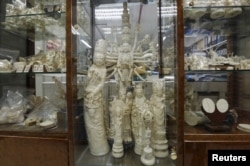The new front in the fight to protect Africa’s imperiled elephants doesn’t begin in the wide savannahs of Kenya, or the scrubby brushland of South Africa.
It begins, says U.S. Fish and Wildlife Service director Dan Ashe, with Americans’ wallets.
“The discussions about ivory trade really revolve around whether you believe demand is part of the solution or not. And in the United States we’ve made that determination that we can’t prevent the extinction of elephants unless we address demand for ivory,” he told VOA on the sidelines of the meeting of CITES, the Convention on International Trade in Endangered Species of Wild Fauna and Flora, held this year in Johannesburg.
The U.S. is pressing that message both at home and abroad this week. A new ad campaign to run on the Discovery channel dissuades Americans from purchasing exotic wildlife products - like shoes, bags, and garments made of rare animals - on their overseas travels.
In June, the U.S. announced a near-total ban on domestic ivory sales. China followed suit and hopes to close its domestic ivory markets within the year. The international ivory trade was banned in 1989.
CITES Secretary-General John Scanlon told VOA that both the U.S. and China have set a positive example for the treaty’s 183 members. If, he says, the world’s two top economies see wildlife trafficking as an economic issue, everyone should.
“We’ve seen great leadership between the U.S. and China, and I must say we’ve seen China really step up the last few years,” he said. “We’ve seen the joint announcements between President Xi Jinping and President Obama. And they did that in the context of the strategic economic dialogue, of all places, to talk about what they’re going to do on tackling wildlife crime.”
The U.S. has taken a strong position in this year’s central debate: it opposes a proposal to legalize the trade of limited amounts of elephant ivory and rhino horn. The conference will also debate a proposal to list all African elephants as endangered.
Conservationists are also pushing Vietnam to take action against the illegal ivory trade. A recent report from conservation group Save the Elephants found that Vietnam is one of the world’s biggest illegal ivory markets.
A report released during the conference by the International Union for Conservation of Nature revealed that the African elephant population has dropped by about 111,000 in the last decade - the worst decline in a quarter century.
Ashe says given this news, these huge but imperiled creatures need all the protection they can get.
“With both elephant and rhino, it’s the same basic equation - the trade today is clearly unsustainable,” he said. “The combination of legal and illegal trade for ivory is unsustainable. The illegal - all illegal - trade in rhino horn is driving rhinoceros towards extinction.”













